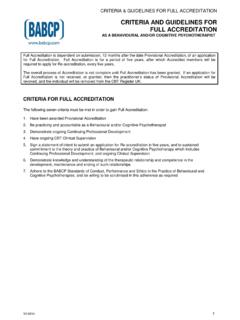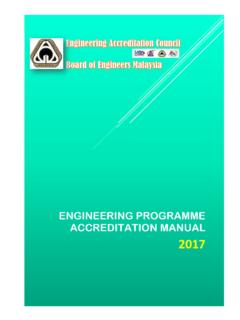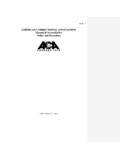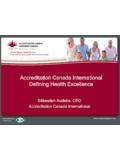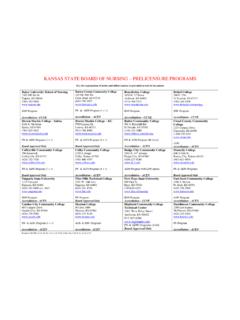Transcription of Accreditation Guidelines 2011 - traumacanada.ca
1 Page 1 of 88 TRAUMA SYSTEM Accreditation Guidelines Trauma Association of Canada Association Canadienne de Traumatologie Fourth Revision June 2011 Page 2 of 88 TABLE OF CONTENTS Section I Accreditation Program 3 Section II Trauma Systems 7 Section III Levels of Trauma Centres 17 Level I 19 Level II 22 Level III 25 Level IV 27 Level V 29 Pediatric Level I 31 Pediatric Level II 34 Adult Centres Treating Pediatric Trauma 37 Section IV Criteria for Provincial & Regional Trauma Systems 38 Section V Criteria for Provincial & Regional Emergency 41 Medical Systems Section VI Criteria for Trauma Centres 43 Section VII References 49 Section VIII Appendices 51 Appendix A 52 Application for Accreditation Appendix B 55 Application for Pre- Accreditation Consultation Appendix C 58 Criteria for Trauma Systems/Centres (Working Document) Appendix D 64 Pre- Accreditation Questionnaire Appendix E 81 Schedule of Site Visit Appendix F 84 Accreditation EvaluationPage 3 of 88 Section I TRAUMA ASSOCIATION OF CANADA Accreditation Background The Trauma Association of Canada (TAC) is a multidisciplinary association of health care professionals committed to promoting injury control and excellence in trauma care throughout Canada.
2 TAC has established formal liaison with Accreditation Canada and has confirmed an MOU in the last three years to work conjointly in the further development of national standards for trauma care. This relationship continues to evolve in the best interests of improving trauma patient care and evidenced based trauma systems development. In 2011 , this Memorandum of Understanding (MOU) between Accreditation Canada and the Trauma Association of Canada (TAC) was revisited and is currently being strengthened. TAC has a national trauma Accreditation /verification program and, building on the work TAC has done in this sector, staff from both organizations will work together to develop a collaborative model. A guiding principle of the MOU is to seek ways to avoid and minimize duplication of efforts for client organizations, and to optimize collaboration with other accrediting bodies.
3 ( ). Currently, (May 2011 ), the relationship between TAC and AC continues to evolve with TAC maintaining an independent trauma Accreditation /verification process as presented in this document. Further details concerning TAC Accreditation can be found at the official TAC Accreditation Committee website through: The Accreditation Committee of TAC has been charged with developing Guidelines for systems of trauma care in Canada and developing a process for evaluating compliance with these Guidelines . The initial TAC Guidelines for Trauma Centre Accreditation were formulated and approved in 1993 and subsequently extensively revised in 2003, 2007 and 2011 with an increasing emphasis on trauma systems. As noted, the Guidelines for trauma Accreditation are periodically updated by TAC in line with recommendations of the TAC executive and its Accreditation Committee.
4 The Accreditation site/system-review process was initiated in 1995 and since then many of Canada s trauma centres/systems have participated in this process. A current list of accredited trauma systems and centres in Canada is provided on the TAC Website ( ). Page 4 of 88 Goals of Trauma Accreditation The primary goal of the TAC Accreditation process is to optimize outcomes for the trauma patient population throughout Canada. The secondary goals are to define national Guidelines and assist health ministries/authorities to develop and sustain trauma services in the paradigm of trauma systems. Development of Guidelines The TAC Trauma System Accreditation Guidelines have been developed by the TAC Accreditation Committee and are based, where possible, on available published evidence and relevant national and international documents.
5 TAC specifically recognizes the work of the American College of Surgeons Committee on Trauma and its document Optimal Resources for the Care of the Injured Patient (2006), the US Department of Health and Human Services document Model Trauma System Planning and Evaluation (Feb, 2006) and the Royal Australasian College of Surgeons Document, Model Resource Criteria for Level I, II, III, & IV Trauma Services in Australasia, August 2009. The TAC Accreditation Committee also acknowledges the extensive input received from the TAC Executive, the membership at large and from previous participants in the Accreditation process. TAC also thanks the collaborative support of Accreditation Canada and the Canadian Association of Emergency Physicians for their input into this document as well as the participation of their membership in the TAC Accreditation Committee.
6 This document has been disseminated widely to the trauma community in Canada as well as all Provincial Governments and Ministries of Health and the Federal Minister of Health. It is also available for review and downloading, with periodic updates, on the TAC Website ( ). Process of Accreditation Compliance with Guidelines for trauma systems and trauma centres is assessed through an Accreditation process performed by TAC. The following are essential steps in this Accreditation process: Appropriate health authority designates optimal number and level of trauma centres for provision of trauma services within its region based on need and system design. Health authority formalizes trauma system configuration and the component parts of the system within the region, consistent with the provincial/regional trauma plan.
7 Health authority develops regional leadership and integrated services consistent with Guidelines for both adult and pediatric patients. Page 5 of 88 Health authority in collaboration with the regional/provincial trauma program leadership, requests a formal Accreditation of its trauma system by TAC including site visits of its Adult and Pediatric Level I III Trauma Centres. A letter addressed to the TAC President requesting Accreditation should be received with a minimum of six months notice of anticipated visit. The letter must be from or clearly sent with the permission of the associated regional/provincial health authority responsible for definitive trauma designation. TAC Accreditation Committee will appoint an expert team comprising of trauma physicians and program manager(s).
8 The Accreditation team leader will communicate directly with the trauma program leaders to arrange the specifics of the site visit and requirement thereof. The Regional Trauma Program/System and each designated Trauma Centre (Level I III) prepare and submit to the TAC office the completed pre- Accreditation questionnaire and supporting documents a minimum of one month before scheduled site visit. Regional Trauma Program/System Leaders must ensure that other system components including Emergency Medical Systems, Emergency Preparedness, Rehabilitation Services, and Level IV and V facilities are in compliance with system Guidelines and prepare to present appropriate documentation at the time of the Trauma System review. The Trauma Program Leaders communicate with TAC Accreditation Team Leader(s) and develop a site visit agenda based on the template provided by TAC.
9 A TAC Accreditation Team will perform a site visit to evaluate the provincial and regional systems and component parts including the major Adult and Pediatric Trauma Centres (Level I III) and their compliance with national Guidelines . Biographies of the accreditors will be made available to the trauma system undergoing Accreditation . A draft report will be submitted to the regional trauma leaders within 6 weeks to confirm accuracy of factual information contained in the report with a request for feedback within seven days. The final Accreditation report will be forwarded to the TAC President s Office within 8-10 weeks of completion of the site visits and then forwarded to the associated CEO of the Regional Health Authority undergoing Accreditation shortly thereafter. TAC will invoice Health Authority for the Accreditation review along with expenses of the Accreditation team members per fee schedule outlined below.
10 The TAC Accreditation process will result in one of the following outcomes: o Successful o Provisional o Unsuccessful Successful TAC Trauma System Accreditation is valid for five years at which time a full Accreditation review will be required to renew status. Applications for a one-year extension on Accreditation status may be granted for extenuating circumstances while a commitment for review is in process. Page 6 of 88 Provisional Accreditation is valid for one year. Within that time frame the Organizations must demonstrate correction of those deficiencies identified in the review, at which time a full Accreditation may be granted. This may require an expedited visit by a TAC Accreditation team. Systems that are unsuccessful will require a new application for a full review.
